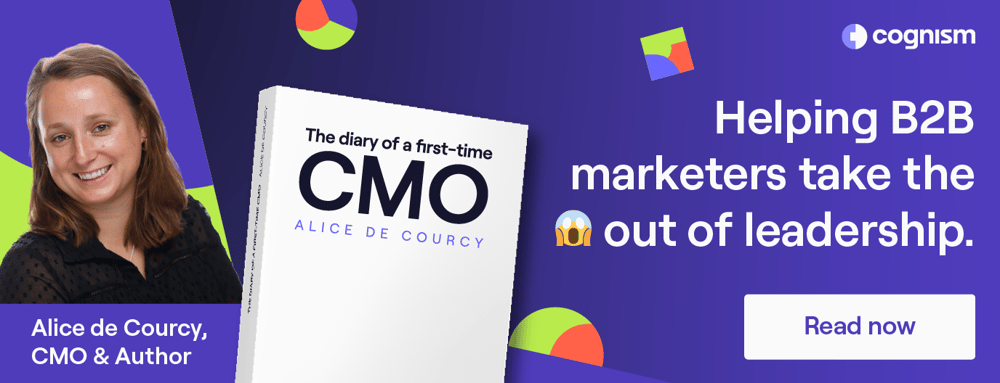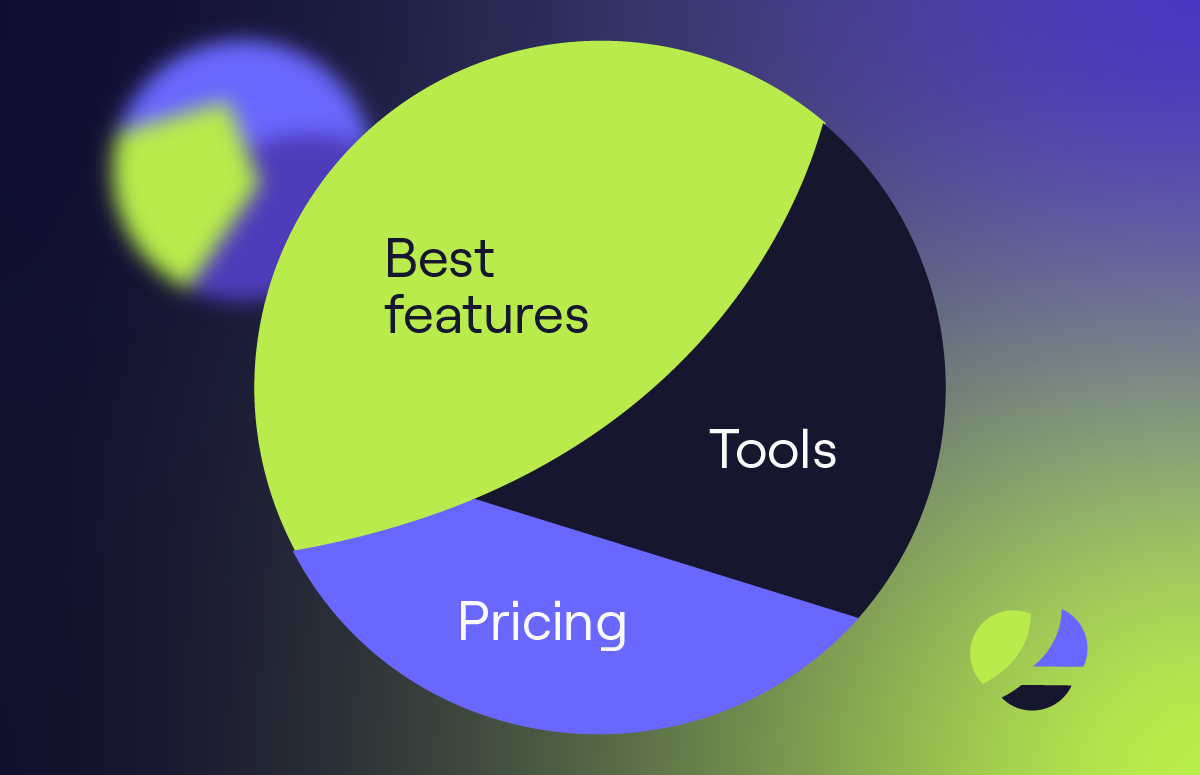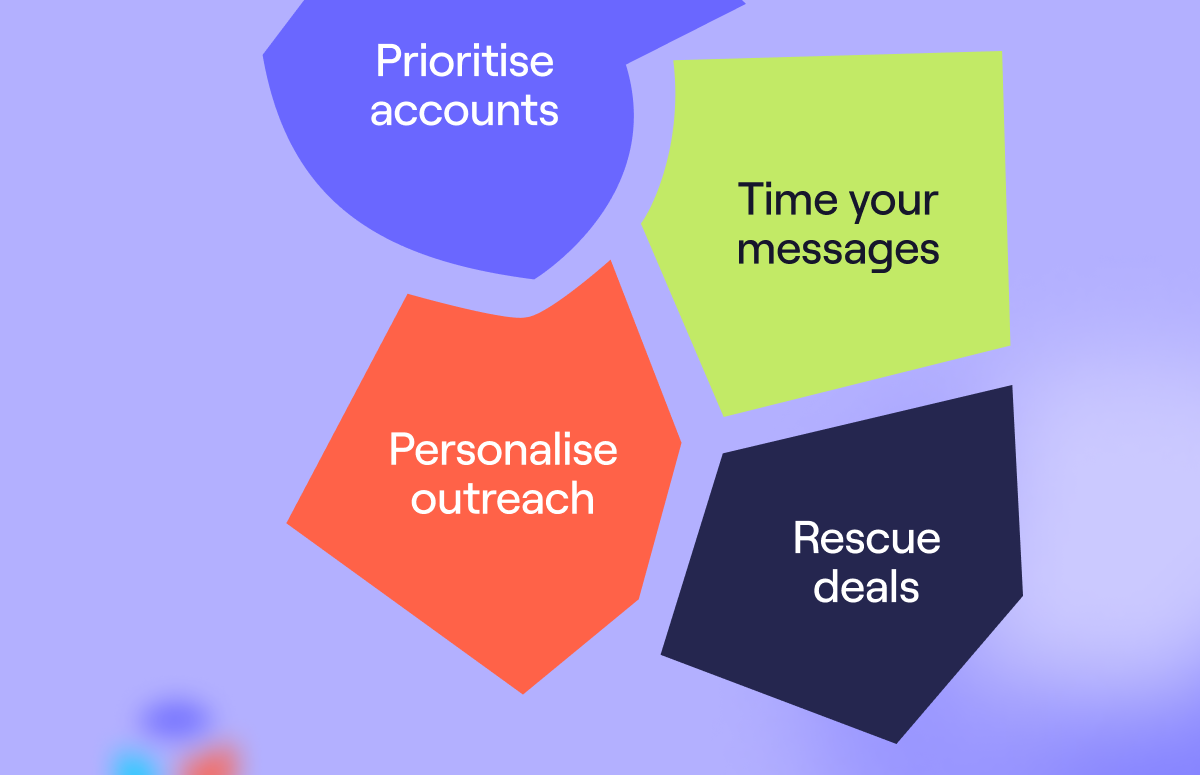Aligning Sales and Marketing - It’s Easier Than You Think!
Aligning sales and marketing - seems like a feat.
Marketing doesn’t know what sales are up to, and sales think marketing lays on the floor in restful yoga poses most of the time.
How can you possibly align the two and get them to see eye to eye?
With this guide, of course! Below we explain:
- Why marketing and sales alignment is important.
- How sales and marketing can align on targets.
- Roles to bridge the gap
Let’s get started 👇
What is sales and marketing alignment?
Marketing and sales alignment is the process of creating shared goals, strategies, and communication channels across teams. This may involve sharing goals, establishing new workflows or merging teams.
By joining forces, teams can create mind-blowing marketing campaigns, level up sales skills, and skyrocket revenue like never before!
But there’s even more to B2B sales and marketing alignment than that; let’s look at the importance of a sales and marketing collaboration 👇
Why align sales and marketing?
Aligning marketing and sales is essential for any business that wants to be successful.
When sales and marketing work together, they can create a powerful synergy that helps the company reach its goals.
By leveraging both departments’ resources, B2B companies can increase their visibility in the marketplace, boost their revenue, and build customer loyalty.
Here are six benefits of sales and marketing alignment:
1. More qualified leads
When both your teams feel like they’re wasting time and resources bringing in leads that go nowhere, the blame game will likely ensue.
And you definitely want to avoid that friction between sales and marketing if you aim for tighter alignment.
To bring in more hot leads, you’ll need:
- A transparent and open feedback loop between the two departments.
- Alignment on what’s working, what should continue, what isn’t working and what to stop.
- Easy access to marketing materials for the sales team.
- A defined method of lead scoring that works for both teams.
Once you’ve implemented these steps, sales and marketing can target your ideal customer profile in unison. Then they won’t be wasting their time on leads that go nowhere.
In line with getting more hot leads through the door, your teams will want to be on the same page about who you’re selling to.
Enter 👇
2. Accurate buyer personas
Sales and marketing are responsible for attracting and nurturing leads; the only difference is how they go about this.
One thing both teams have got to be clear on is buyer personas.
Your buyer personas need to be accurate depictions of your perfect clients. If not, your marketers and sales reps will follow the wrong paths and chase the wrong people.
How do you get your teams aligned around buyer personas? It’s simple:
Shared ownership.
If your sales and marketing teams feel they play an equal part in creating your personas, they’ll work incredibly hard to get them right.
It relates to having open lines of communication between the two teams.
Your sales reps work daily on the front line, speaking and engaging with prospects. They can give invaluable feedback to your B2B marketing team on the content that’s working or not working with your audience.
They can also share insights into what content your marketing team should create to improve lead quality and quantity. Such as:
- Trends they’ve noticed.
- Content that leads have asked for.
- Any industry or competitor product news.
Getting the right content in front of the right people is critical to the success of both your sales and marketing teams!
Another benefit of sales and marketing alignment? 👇
3. A clear buyer’s journey
When building sales funnels, it’s easy for your teams to lose sight of how well they’ll work for your prospective customers.
Instead, the focus is often on how they’ll benefit your people.
You must put the customer first and adopt an account based marketing strategy.
This approach will give you a clearer idea of your buyer’s pains and objectives, which you can address at each stage of the customer journey.
Here’s where your teams should keep an eye on the type of content your potential customers are downloading.
Then, they need to meet the needs signalled.
It’s essential to ensure that your teams aren’t wasting your prospects’ time or sending them around in circles.
When sales and marketing align on the buyer journey, you can easily avoid this.
Speaking of keeping an eye on B2B content… You’ll want to ensure you’re putting out 👇
4. Relevant and engaging content
Only 32% of marketers and 43% of salespeople believe the sales function makes complete and effective use of marketing content.
These figures are surprisingly low and slightly worrying!
Both teams must emphasise the content produced - which is vital to the alignment process.
How does this work in practice?
Let’s say the same questions are coming up repeatedly from your customer base. If sales report this to the marketing department, they can create content addressing those questions.
Not only will this content greatly benefit your prospects, but it will also save your sales team a lot of time.
The bottom line is:
The more helpful content you generate, the easier sales and marketing jobs will become!
5. Creation of a feedback loop
It may have come up a few times in this blog, but it’s just that important!
The feedback loop between your sales and marketing teams will help them meet or beat targets - or miss them entirely.
There needs to be constant communication between the two teams. You can achieve this by:
- Arranging weekly team meetings to share results and learnings.
- Focusing on the prospects’ needs (see point 3).
- Deep dives into customer and revenue data (ask your RevOps team to chair these meetings)
- Being transparent about KPIs and targets.
If your teams constantly relay feedback to each other while chasing their targets, they’re sure to create success.
Lastly, aligning sales and marketing is going to result in 👇
6. Increased revenue
Who doesn’t want their business to generate more money?
Our guess? No one!
Our CMO, Alice de Courcy, strongly believes both sales and marketing should be working towards and owning a revenue goal.
“Your marketing team must own a number that’s traceable to revenue. Everyone in the team should understand the business goals and lead generation KPIs, and from there, understand the team’s revenue goals, KPIs and metrics.”
Essentially, marketing should chase revenue targets as your sales team does.
Not only should each team be chasing a revenue target, but B2B marketing and sales alignment are essential for successful lead nurturing.
Why?
Because according to HubSpot, a lack of alignment costs $1 trillion annually!
This all comes down to 79% of leads not converting into sales due to a lack of nurturing.
73% of those leads never get contacted; if they are, no one follows up with them.
Alice explains how Cognism combats this problem:
“We’ve set up steps to ensure the importance of business is not lost between our sales and marketing teams. These include having agreed upon SLAs with inbound MDRs and keeping tabs on actioned leads through daily automated Salesforce reports sent to management.”
Once you’ve combated missed opportunities through solid sales and marketing alignment, your revenue could increase by 208% compared to your previously disjointed teams.
That’s a fair chunk of change!
So, what are you waiting for?! Go on and get those teams aligned!
And for even more help along the way? Read on for our tips on implementing sales and marketing alignment 👇
How do you align sales and marketing? 3 top tips!
How can you achieve marketing and sales alignment for improved effectiveness?
Here are three top tips from Alice de Courcy and Cognism’s VP of Global Sales, Jonathon Ilett, to help you get started:
1. Align on targets
In B2B sales, your targets underpin your revenue engine.
Meaning your target determines your:
- Headcount allocation
- And your predicted revenue
Cognism is a very metrics-driven organisation, so we work off the predictable revenue model.
Jonathon explains how this works:
“When you look at it from an SDR cold outbound perspective, it’s easy to draw synergy between the number of demos you need and opportunities to close. And then the way we do this from a marketing perspective is unique. Our marketing team has a target on their head.”
So, how does that work?
It’s much the same as your outbound sales team would have.
Each month, the marketing team is responsible for meeting their target.
Cognism made this predictable by measuring many components individually and creating a fixed conversion rate.
Jonathon elaborates on this:
“With our marketing team, there are two focuses for us: content leads and inbound leads. When we look at the content leads, we treat these as cold leads - so the MDR team gets comped exactly as they would for a cold lead from nowhere but with a warmer introduction.”
Cognism also evaluates its SQOs and determines how many deals will come from them.
And then, from all of these metrics, sales and marketing align by giving marketing an ultimate revenue target.
We treat these leads as golden leads. They get very clear SLAs on how quickly these inbound leads need action.
Alice doubled down on how important actioning your inbound marketing leads is:
“At Cognism, from the management layer, the importance of these inbound leads is set. Their importance to the business must be continuously stressed, as this can get lost occasionally.”
Alice walks us through the steps Cognism has to ensure the sales team understand the importance of these leads:
- Having agreed SLAs with the inbound MDRs.
- Specialising the MDR role (read on to see how 😉)
- Daily automated Salesforce reports get sent to all management at the end of the day (this is to keep tabs on actioned and unactioned inbounds within the SLAs.)
- Steps to follow when the inbounds have not been actioned.
However, when aligning sales and marketing, Alice cautions against marketing being completely reactionary to sales requests.
“Being in reactionary mode makes it very difficult for the team to have a marketing plan and execute a strategy. The way to avoid this is for marketers to set a clear strategy and plan. All the key stakeholders that need to know about it should sign it off.
Then, you should set an expectation with the rest of the business, especially sales, that you have 80% capacity focused on that plan and executing that strategy, and then you action ad hoc requests from sales and other parts of the business with the additional 20% of your capacity. This means you won’t be constantly distracted from your marketing goal.”
As your marketing team brings the plan to life, your business will see how successful they are in meeting its revenue target.
And they’ll see the value of focusing on the goal rather than being distracted by things outside it.
Alice suggests going to your leadership and getting a revenue number for your team if you don’t already have one.
Why?
Because when you make the shift to your marketing team owning a revenue number, you’ll see that it gives you:
- A much stronger seat with the board and with management.
- It aligns you with sales so much better.
Once you’ve got this in place, you’ll want to look at your lead attribution to track the leads coming in from your marketing activity.
Alice explains the technicality of this:
“Essentially, it all starts with enabling all of your forms - so that you’re tracking your UTM links. Ensure you’re using UTM links for absolutely everything you’re doing. And that you’re pushing those UTM parameters through your forms. Capture any hidden UTMs on the form level, and set your Salesforce app to capture this."
"The three UTM parameters Cognism tracks are lead source, campaign type, and characteristic. This lets us track the lead from a lead contract level to the opportunity and close-won stage.”
Cognism also uses a U-shaped attribution model built out in Salesforce.
Once you’re on top of aligning sales and marketing with a common revenue goal, you’ll want to look at one key player 👇
2. The role of MDRs
MDR?
Never heard of them.
You’ll soon want to create this role in your team for better alignment between sales and marketing.
A marketing development representative is solely responsible for any leads attained from the marketing function and the basis for their target.
That includes leads that come through from:
- Content
- Webinars
- Events
Jonathon expands on the MDR role:
“The beauty of this role is that they sit hybrid between the sales and marketing functions. They directly report to sales and get all the sales training on standard sales processes regarding how they action leads. Still, they also receive feedback directly on any content marketing channels we focus on at Cognism. Essentially they’re reporting to both a sales leader and our CMO.”
“The way I like to view it is that SDRs target cold leads - they’re basically spearfishing, whereas an MDR’s primary focus is to qualify out leads. They have much more in-depth conversations, like an Account Executive would on a discovery call. The benefit of this is that the talent pool of your MDRs progresses much faster towards those AE roles.”
The MDR plays a crucial role in actioning leads.
They are the first marketing professional to approach potential clients, so a lot of revenue will come from these conversations.
As a result, you should be comping this role on a commission-based structure—the same way you would for your outbound leads.
And to make sure it’s as incentivising too.
Alice has a list of tips on how to implement this role into your team:
- Keep the role within the sales structure. There should be an alignment between marketing and MDRs, but the position should sit within the sales function.
- Position the role as a promotion. To align with the idea of these leads being better than outbound leads.
- Specialise the role. There’s a lot of value in having a position specialising in content to produce inbound and outbound leads to distribute to your SDRs.
- Respond fast. Ensure your MDRs are actioning your inbound leads within a few minutes. At Cognism, we aim for five.
- Tie it to your compensation model.
- Have an open feedback loop between your MDRs and the marketing team.
🎥 Watch Alice and Jon explore the MDR role in sales and marketing alignment in this video:
3. Invest in a revenue team
“The way we view the revenue team is that we combine all the key leadership figures responsible for actually getting that revenue number.”
Jon goes on to explain who makes up Cognism’s revenue team:
“We have our revenue ops department, marketing ops, SDR manager, Account Executive manager, and marketing team. We have bi-monthly syncs where we review the key initiatives we’re working on that are likely to impact those departments or strategise on a particular issue - like a campaign roll-out, for example. We also align on departments and their promotion paths.
We also have a weekly kick-off where we bring all our marketing and sales employees together. In the meeting, each department goes through its performance by channel - this is incredibly important as each department is very clear on its attribution in terms of revenue. The kick-off aims to go through our processes on a granular level and celebrate wins with rewards.”
Another great way to integrate your teams into your revenue team is through a Slack channel.
It’s a positive channel where you can share meetings booked, signed deals, and opportunities created.
This is an excellent way to connect sales and marketing and break down the traditional silos between them!
💡Tip! Discover more about aligning sales and marketing strategies with this article on inbound vs outbound marketing.
Marketing and sales alignment FAQS
Q. Are sales and marketing alignment the same as ABM?
No, sales and marketing alignment is not the same as ABM. Aligning sales and marketing teams requires both departments to work together to create a unified strategy for reaching and engaging customers. This includes ensuring everyone is on the same page regarding messaging, target markets, customer acquisition strategies, account management tactics, and more.
ABM, or account-based marketing, is a strategy for targeting specific customers and accounts. It requires a deep understanding of each customer’s unique needs and preferences to create custom campaigns that convert them into paying customers. ABM campaigns typically involve personalised content, tailored messaging, and highly targeted outreach efforts.
Q. How do you measure the impact of sales and marketing alignment?
Evaluating how well your teams align can be done by monitoring and tracking metrics or KPIs.
Tracking customer engagement is the most crucial measure of success for sales and marketing alignment.
How do customers interact with your brand?
Are they taking action, making purchases, browsing your website, or attending events?
Knowing how customers engage with your company can help you adjust your strategies accordingly.
Another important metric to track is cost-per-acquisition (CPA). CPA measures the total cost of acquiring a customer through sales and marketing efforts. This metric helps you understand which channels are most effective and which to optimise for better results.
You should also track customer lifetime value (CLV). CLV measures each customer’s total revenue throughout their relationship with your business. This metric helps you understand how much revenue each customer generates and lets you focus on acquiring higher-value customers.
Q. What are some sales and marketing alignment best practices?
There are several best practices when it comes to aligning sales and marketing. Here are the top four:
1. Establish clear goals: Sales and marketing teams should set clear goals for themselves and each other so everyone knows what to work toward and how to achieve it. This could include specific targets for lead generation, customer conversion rates, etc.
2. Develop shared KPIs: Key performance indicators (KPIs) help measure success, so sales and marketing teams should develop a shared set of KPIs that they can use to monitor progress and guide their efforts.
3. Create a single source of truth: Each team should have access to the same data and information so all decisions centre around the same set of facts. This could involve creating a single dashboard that everyone can access or using a CRM system shared by both teams.
4. Integrate communication channels: Sales and marketing teams should also integrate their communication channels to relay messages back and forth quickly.
Aligning sales and marketing revenue is easy with Cognism
Sales and marketing alignment takes the right tools, mindset and focus to succeed.
With better B2B data shared across teams, the better your conversations. And that’s just the cherry on top when it comes to using Cognism to help align sales and marketing for greater ROI:
- Move the needle on each team’s potential with a united, data-backed strategy.
- Calculate your TAM, plan territories and enrich your data for accurate segmentation, scoring, and routing.
See how it works. Book a demo by clicking the banner below 👇




